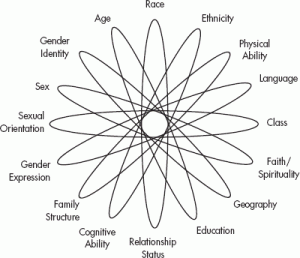DVN Offers New Training: Domestic Violence in the LGBTQ Community
By: Kelsey Gurganus, Director of Research & Evaluation, DVN
In our ever-changing and evolving world, knowing what to say about identity and how to say it is really important when it comes to being inclusive, equitable, compassionate, safe, and empathetic as an advocate, service provider, friend, ally, neighbor, and loved one. The figure below is a good visual of the dimensions that make up our individual identity. Within each dimension is a whole world of identities. I want to bring attention to a few of these dimensions that seem to have many questions around them.
Figure 1. Dimensions of Identity
Source: Allegheny County, Pennsylvania, DHS LGBTQ Community Training Team/SOGIE Project Team.
Often people are afraid to discuss sexual orientation, gender identity, and gender expression because they are afraid they may say the wrong thing. It is essential that we empower ourselves to know the words and meanings to help make conversations easier and more comfortable for everyone, especially survivors of domestic and sexual violence.
Our wonderful partners at the Indiana Youth Group (IYG) have a whole wealth of knowledge, expertise, and resources for you to learn more. For terms and definitions, check out IYG’s LGBTQ101 Words and Terms to Know page! Below are some broad definitions to get you started:
- Sexual Orientation – a term frequently used to describe a person’s innate romantic, emotional, or sexual attraction to another person. Use the term sexual orientation instead of “sexual preference,” “lifestyle,” or other misleading terms. This dimension includes identities such as Gay, Lesbian, Queer, Bisexual, Pansexual, Asexual, etc.
- Gender Identity – a person’s deeply felt sense of being male, female, something other, or, in between. Everyone has a gender identity. This dimension includes key terms and identities such as transgender, bigender, cisgender, genderqueer, gender non-conforming, etc.
- Gender Expression – an individual’s characteristics and behaviors, such as appearance, dress, mannerisms, speech patterns and social interaction.
- Sex (biological) – the physical anatomy and gendered hormones one is born with, generally described as male, female, or intersex, and often confused with gender.
Knowing these terms, definitions, and what they encompass is especially important when working with young people. Learning how young people identify themselves (and terms that may be offensive) is helpful and important, but it can be hard to keep up. Here are a few helpful guidelines around terminology adapted from the Council of Juvenile Correctional Administrators (CJCA):
- Allow the young person to self-identify (when ready).
- Mirror their language.
- Ask questions in a respectful way to help you understand what the language they use means to them.
- Adjust if and when identity and expression shifts – language, identity, and expression are fluid, especially for adolescents.
Individuals identifying as LGBTQ+ have a higher risk of domestic and sexual violence victimization. DVN’s new training coordinator, Ashley Powell, has been working very hard on new materials to ensure we are providing the most inclusive and best trainings for all affected by domestic violence. The training is called Domestic Violence in the LGBTQ Community and is available to all community members. This training will provide the trainees with knowledge of the warning signs of domestic violence, and the specific barriers the LGBTQ Community faces. This training will also discuss best practices when working with LGBTQ victims of domestic violence, and educate the trainees on LGBTQ friendly local resources. For more information or to find out how you can get this free training, contact Ashley at: apowell@dvnconnect.org.
